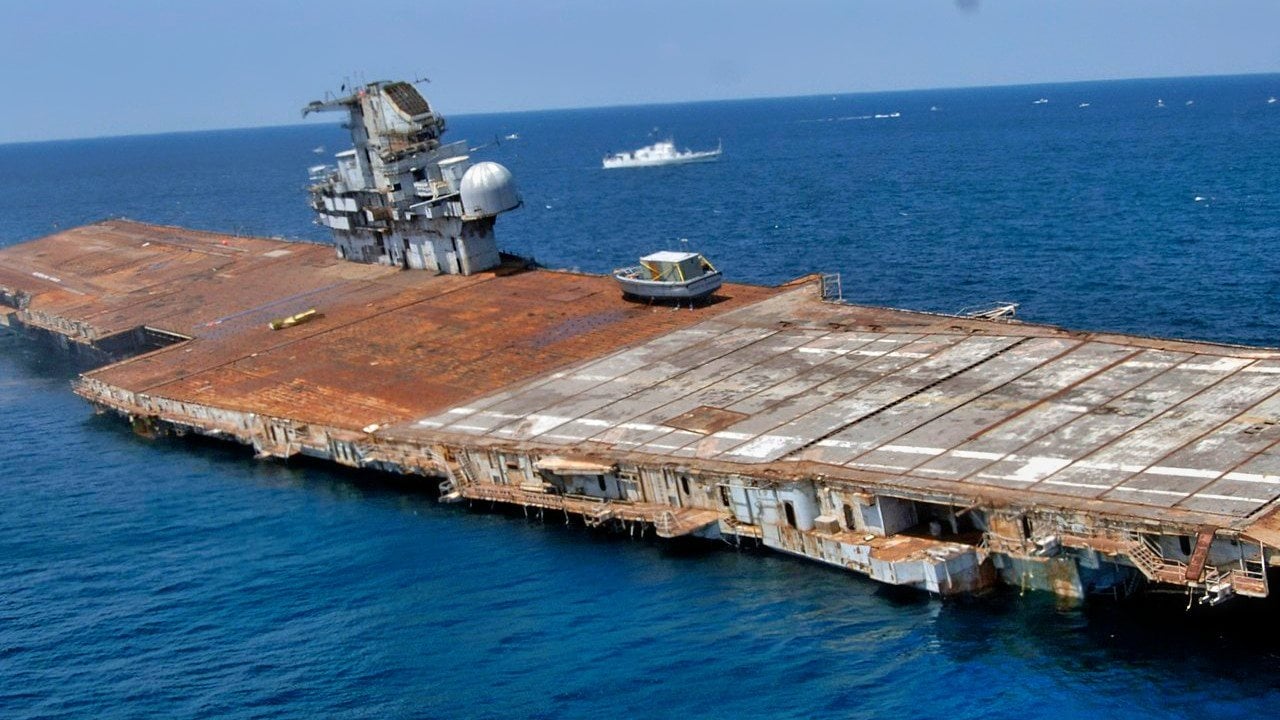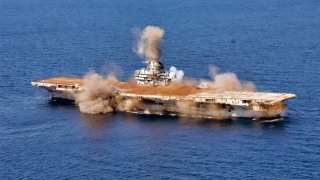USS Oriskany: The Essex-Class Aircraft Carrier The Navy Sunk On Purpose
The USS Oriskany (CV-34), an Essex-class aircraft carrier, served with distinction in the Korean and Vietnam Wars, earning the nickname "The Mighty O." Laid down during World War II, the Oriskany was adapted for modern warfare, conducting airstrikes and engaging in the first multi-jet aerial dogfight in history.
Summary and Key Points: The USS Oriskany (CV-34), an Essex-class aircraft carrier, served with distinction in the Korean and Vietnam Wars, earning the nickname "The Mighty O."

-Laid down during World War II, the Oriskany was adapted for modern warfare, conducting airstrikes and engaging in the first multi-jet aerial dogfight in history.
-After its decommissioning in 1976, the ship was considered for a museum but was ultimately sunk off the Florida coast in 2006 to create the world’s largest artificial reef, now known as "The Great Carrier Reef," a unique and fitting final resting place for this storied vessel.
USS Oriskany: From “The Fighting O” to the “Great Carrier Reef” A Life of Service
Twenty-two miles off the coast of Florida’s idyllic panhandle and 200 feet beneath the waves of the bucolic Gulf of Mexico is the final resting place for one of America’s most iconic warships. Known to tourists all over the world as “The Great Carrier Reef,” the sunken wreck of the USS Oriskany was made into the world’s largest manmade reef in 2006. This is a strange final stop for a warship that participated in some of the United States’ biggest wars of the last half of the previous century.
The USS Oriskany (CV-34) was first laid down in 1944 and launched in 1945. A member of the legendary Essex-class attack aircraft carrier, the Oriskany was ultimately commissioned by the United States Navy in 1950. The Essex-class carriers were designed to fight—and defeat—the navies of the Axis Powers of the Second World War, specifically the Imperial Japanese Navy. Unfortunately for the original designers of the Oriskany, the great ship would not make it out of the shipyards before the war’s end.
Not to fret, though. The Oriskany was quickly adapted for the modern age of warfare that dominated the post-World War II era.
What’s In a Name?
CV-34 was named after the site in central New York State of the bloodiest battles fought between American rebels and the British Army in the Revolutionary War. That battle fought in the summer of 1777 for control over the Mohawk Valley, resulted in a stalemate that saw half the original American force lost in the battle.
Naming CV-34 the USS Oriskany was an homage to that incredible battle.
Interestingly, CV-18, the USS Wasp, was originally to be named Oriskany.
The USS Oriskany had a displacement of 27,100 tons and a length of 888 feet. Her top speed was thirty-three knots (or thirty-seven miles per hour). This boat carried a crew of around 3,460. She was armed with eight, 5-inch guns, 14.3-inch guns, and eighty aircraft.
Her Incredible History
CV-34 was deployed to the Pacific to support US and allied forces that were called upon to repulse North Korea’s illegal invasion of South Korea. Oriskany conducted what was known as “night heckler” missions, deploying its airwing on strafing and bombing runs on communist truck convoys, air strikes on enemy front-line positions, and multiple road and bridge cuts near Yangdok.
Indeed, jet warplanes from the Oriskany successfully engaged seven Soviet MiG-15s, shooting two down and damaging an additional two. History records this engagement as the first multi-jet aerial dogfight by Navy warplanes.
Oriskany lost many birds in the Korean War, too. The operational tempo for the ship’s airwing was so great that even the flight deck crew suffered a death when a sailor was run over by an F48\U Corsair. Nevertheless, Oriskany’s service in support of the US-led effort to restore stability on the Korean Peninsula was wildly successful.
This great boat would earn its first battle star for its meritorious service in the Korean War.
During the Vietnam War a decade later, Oriskany was a key player in the naval air war over the southeastern Asian nation. She conducted airstrikes from Dixie Station as well as Yankee Station. In 1965, Oriskany would be given the Navy Unit Commendation for its role in conducting over 12,000 combat sorties.
Its prolific presence in the Vietnam War would allow for the Oriskany to earn its second battle star.
A Strange and Unique Ending
By the time the war ended, the carrier had amassed an impressive service record that lived up to its nickname of “The Mighty O.” In 1976, Oriskany was decommissioned and taken to Bremerton, Wash., where it was held in reserve as a possible museum ship. At one point, the Japanese were interested in making the ship into a museum.

Ultimately, however, the Navy chose to send the legendary carrier to the bottom of the drink, citing excessive costs of dismantling and possible environmental hazards if the warship were scrapped conventionally.
Thus, the Great Carrier Reef was born and remains a site to behold today.
Author Experience and Expertise: Brandon J. Weichert
Brandon J. Weichert, a National Interest national security analyst, is a former Congressional staffer and geopolitical analyst who is a contributor at The Washington Times, the Asia Times, and The-Pipeline. He is the author of Winning Space: How America Remains a Superpower, Biohacked: China’s Race to Control Life, and The Shadow War: Iran’s Quest for Supremacy. His next book, A Disaster of Our Own Making: How the West Lost Ukraine, is due October 22 from Encounter Books. Weichert can be followed via Twitter @WeTheBrandon.
All images are Creative Commons or Shutterstock.


